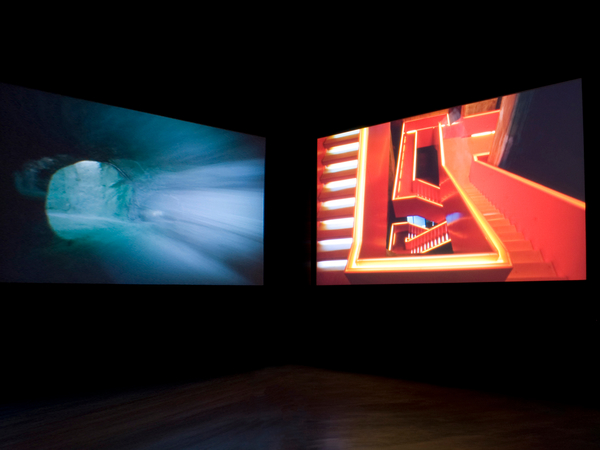The City / The Cut, 2008
The City / The Cut
2008
4-channel film installation
overture to theatre plays The City and The Cut, written by Martin Crimp and Mark Ravenhill,
and directed by Thomas Ostermeier at Schaubühne am Lehniner Platz, Berlin, 2004
Colour, sound
Shot on Super 16mm
Aspect ratio 16:9
22 min, 20 sec
Rosefeldt’s video installation sets the scene for director Thomas Ostermeier’s amalgamation of artistic endeavours. Defying theatrical conventions, The City / The Cut brings together two plays (The City by Martin Crimp, The Cut by Mark Ravenhill), a musical performance by Alex Nowitz, a dance performance choreographed by Constanza Macras, the stage design of Jan Pappelbaum, and Julian Rosefeldt’s four-channel film for an immersive theatre installation. Paranoia, isolation and perpetual unease are dominant themes in the production, in which distrust for both the state, those among us and our everyday reality weigh upon our prosperity and happiness.
Rosefeldt’s four-channel video installation, later developed into the work titled The Shift (2008), serves as a prologue for the Schaubühne production. The film reveals a protagonist who is once again a lonely wanderer, moving slowly through a science-fiction setting, a giant network of tunnels and various control rooms filled with outdated technology. By changing his clothes, he slips into four different roles – a janitor, a security guard, a scientist and a sewer cleaner – and yet his character does not change. He remains a Cerberus, taking care of an engineered and machine-run environment which long ago started working autonomously, without the need of human interference. References to science-fiction classics such as Stanley Kubrick’s 2001 – A Space Odyssey and Andrei Tarkovsky’s Solaris are evident both in image and sound – as, for instance, when the protagonist steps out of a star gate into a white, icy desert. Eventually, what appeared to be an exit from this closed and claustrophobic circuit turns out to be just another inhospitable landscape, and a metaphor for solitude. The film loop continues, and the roaming man appears again, dressed differently, starting over his daily routine.
The work speaks of the growing isolation of human beings driven by the increasing impact of technics and media, as well as their alienation from nature. It draws a melancholic picture of what people once enthusiastically hoped would be the better future. The unsettling nature of the film’s estranged individual is reflected in the theatre audience’s experience: Ostermeier’s constructed labyrinth invites visitors to find their own way around. The resulting combination emerges as a confrontation of internal anxiety and fear of the future – a predicament for both the individual and its collective society. In some ways, the film installation is as much a prologue as an epilogue; the uncertainty prevails throughout, and the loop of isolation and futility persists. Rosefeldt refers here to the French philosopher Paul Virilio’s term of a society consisting of "multiple solitudes" (see also Julian Rosefeldt and Piero Steinle’s interview with Virilio in their publication news). Capitalism’s promise is failing, omnipresent mechanisms of control are exploiting authenticity and individual freedom, all whilst dystopia is transforming into reality.
E. Lapper and L. Korndörfer
Film Credits
Wolfgang Stein (Janitor, Security Agent, Scientist, Sewage Worker)
Director of Photography: Christoph Krauss
Production Managers: Sandi Knape, Wassili Zygouris
Production Designer: Sven Geßner
Costume Designer: Almut Eppinger
Steadicam Operator: Sergio Gazzera
Assistant Director of Photography: Frederik Tegethoff
2nd Assistant Director of Photography: Niklas Hoffmann
Gaffer: Oliver Mehlis
Electricians: Niko Mölter, Christof Stammberger, Matthias Pilz, Adrian Balladore
Crane Operator/Key Grips: Orlando Grübel
Assistant Editor: Arturo Martinez
Sound Design/Sound Editors: Florian Kühnle, Markus Stemler, Sebastian Melichar
Foley Artist: Felix Kratzer
Sound Recording: Jacob Ilgner
Sound Mixing: Christoph Andrich
Assistent Production Manager: Valeria Schwarz
Assistant Production Designer: Andreas Liebig
French Horn: Gisbert Näther
Set Photography: Benedikt Partenheimer
Compositing: PICTORION – das werk Berlin GmbH
Acknowledgements:
Schaubühne am Lehniner Platz, Thomas Ostermeier, Tobias Veit, Friedrich Barner, PICTORION – das werk Berlin GmbH, Arri Rental Berlin, Arri Schwarzfilm Berlin GmbH, Studio Hanse Warns, Tonbüro GmbH, Kodak Berlin GmbH, Medias Reiseservice GmbH, Agentur Iris Müller, A Huber & Co Internationale Assekuranz Makler GmbH, Maritim Hotel Gelsenkirchen, Martin Neander, ICC Berlin, Messe Berlin GmbH, Olympiastadion Berlin GmbH, Krematorium Berlin, Deutsche Oper Berlin, Humboldt-Universität zu Berlin, Förderband Kulturinitiative Berlin, Berliner Wasserbetriebe, Philologische Bibliothek der Freien Universität Berlin, Umspannwerk Humboldt, Berliner Wasserbetriebe, MARUM – Zentrum für Marine Umweltwissenschaften, Bremen, CERN European Organization for Nuclear Research, Erlebnisbergwerk Sondershausen, Forschungszentrum Jülich, AC Serendip Ltd, Tippin Corporation, Vattenfall Europe Transmission GmbH, Entwicklungsgesellschaft Zollverein mbH, Stiftung Industriedenkmalpflege und Geschichtskultur, Essen, EADS Astrium GmbH Bremen, Flughafen Bremen GmbH, Flughafen Tempelhof
Co-produced by:
Schaubühne am Lehniner Platz, Berlin
Shot in Germany and Switzerland, 2008
Written, directed and produced by Julian Rosefeldt
All rights reserved © Julian Rosefeldt

